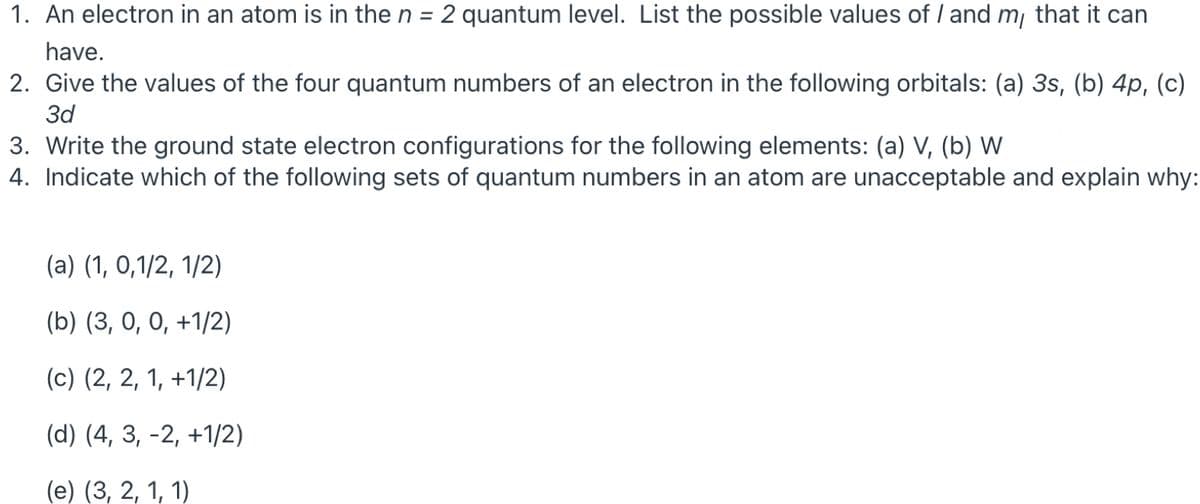1. An electron in an atom is in the n = 2 quantum level. List the possible values of / and my that it can have. 2. Give the values of the four quantum numbers of an electron in the following orbitals: (a) 3s, (b) 4p, (c) 3d
1. An electron in an atom is in the n = 2 quantum level. List the possible values of / and my that it can have. 2. Give the values of the four quantum numbers of an electron in the following orbitals: (a) 3s, (b) 4p, (c) 3d
Chemistry: An Atoms First Approach
2nd Edition
ISBN:9781305079243
Author:Steven S. Zumdahl, Susan A. Zumdahl
Publisher:Steven S. Zumdahl, Susan A. Zumdahl
Chapter2: Atomic Structure And Periodicity
Section: Chapter Questions
Problem 96E: In the ground state of element 115, Uup, a. how many electrons have n = 5 as one of their quantum...
Related questions
Question
1. An electron in an atom is in the n = 2 quantum level. List the possible values of / and my that it can
have.
2. Give the values of the four quantum numbers of an electron in the following orbitals: (a) 3s, (b) 4p, (c)
3d
3. Write the ground state electron configurations for the following elements: (a) V, (b) W
4. Indicate which of the following sets of quantum numbers in an atom are unacceptable and explain why:
(a) (1, 0,1/2, 1/2)
(b) (3, 0, 0, +1/2)
(c) (2, 2, 1, +1/2)
(d) (4. 3. -2. +1/2)
(e) (3, 2, 1, 1)

Transcribed Image Text:1. An electron in an atom is in the n = 2 quantum level. List the possible values of / and m¡ that it can
have.
2. Give the values of the four quantum numbers of an electron in the following orbitals: (a) 3s, (b) 4p, (c)
3d
3. Write the ground state electron configurations for the following elements: (a) V, (b) W
4. Indicate which of the following sets of quantum numbers in an atom are unacceptable and explain why:
(a) (1, 0,1/2, 1/2)
(b) (3, 0, 0, +1/2)
(c) (2, 2, 1, +1/2)
(d) (4, 3, -2, +1/2)
(е) (3, 2, 1, 1)
Expert Solution
This question has been solved!
Explore an expertly crafted, step-by-step solution for a thorough understanding of key concepts.
This is a popular solution!
Trending now
This is a popular solution!
Step by step
Solved in 2 steps

Knowledge Booster
Learn more about
Need a deep-dive on the concept behind this application? Look no further. Learn more about this topic, chemistry and related others by exploring similar questions and additional content below.Recommended textbooks for you

Chemistry: An Atoms First Approach
Chemistry
ISBN:
9781305079243
Author:
Steven S. Zumdahl, Susan A. Zumdahl
Publisher:
Cengage Learning

Chemistry: The Molecular Science
Chemistry
ISBN:
9781285199047
Author:
John W. Moore, Conrad L. Stanitski
Publisher:
Cengage Learning

Chemistry & Chemical Reactivity
Chemistry
ISBN:
9781133949640
Author:
John C. Kotz, Paul M. Treichel, John Townsend, David Treichel
Publisher:
Cengage Learning

Chemistry: An Atoms First Approach
Chemistry
ISBN:
9781305079243
Author:
Steven S. Zumdahl, Susan A. Zumdahl
Publisher:
Cengage Learning

Chemistry: The Molecular Science
Chemistry
ISBN:
9781285199047
Author:
John W. Moore, Conrad L. Stanitski
Publisher:
Cengage Learning

Chemistry & Chemical Reactivity
Chemistry
ISBN:
9781133949640
Author:
John C. Kotz, Paul M. Treichel, John Townsend, David Treichel
Publisher:
Cengage Learning

Chemistry for Engineering Students
Chemistry
ISBN:
9781337398909
Author:
Lawrence S. Brown, Tom Holme
Publisher:
Cengage Learning


Chemistry
Chemistry
ISBN:
9781305957404
Author:
Steven S. Zumdahl, Susan A. Zumdahl, Donald J. DeCoste
Publisher:
Cengage Learning